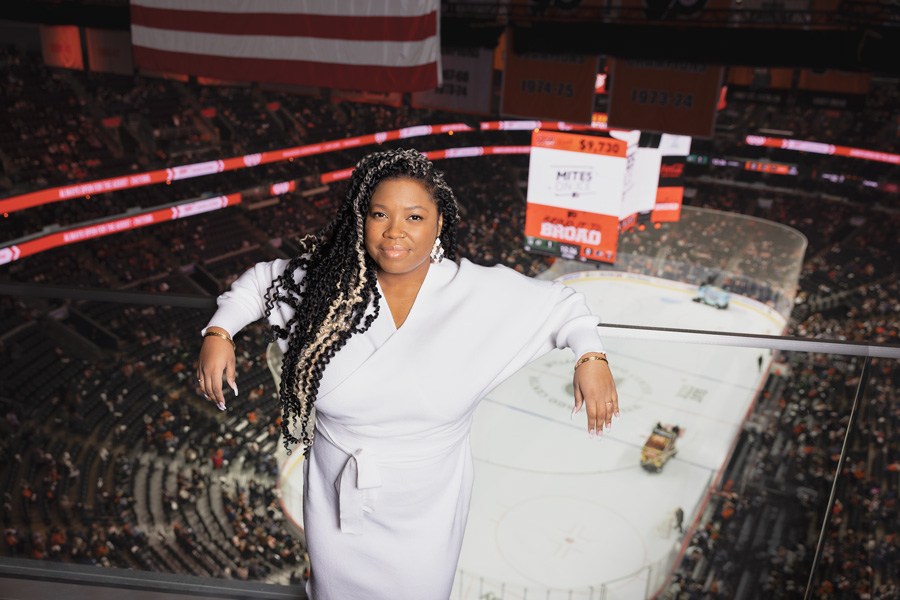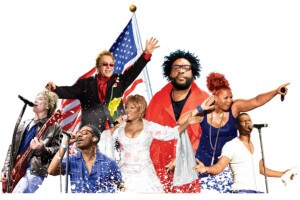The Inside Story of the Flyers’ Fan Code of Conduct
How (and why) the team best known for beating people up is on a mission to take the bullies off Broad Street.

Lyric Hamilton, events director for the Flyers, led the campaign to update the team’s groundbreaking fan code of conduct. / Photograph by Colin Lenton
In the spring of 2021, the Wells Fargo Center was gearing up to let fans back into the arena for the first time since the start of the pandemic. In press releases and videos, management touted the changes it had been making to keep up with the times: a new $11 million HVAC system that replaces all the air in the building every 30 minutes. A “clean team” that wipes down door handles and escalator rails. Contactless parking, ticket-taking, and food and merch sales. Masked attendants with thermometer guns by the doors. Hand sanitizer everywhere. The place was willing to do whatever it took to make guests feel comfortable enough to come back.
Still, Lyric Hamilton felt that a piece of the safety puzzle was missing. As events director for the Flyers, Hamilton can be spotted everywhere in the arena on game days, from the dreary basement corridors to the high-tech production booth in the rafters. Most often, you’ll find her circling the concourse level, where the fans, who are predominantly white, interact with an events staff that’s usually around 50 percent people of color.
Hamilton, a 27-year-old Black woman who grew up in West Oak Lane and studied theater management at Penn State, says she’s felt at home working at the Wells Fargo Center over the past three years; a hockey arena isn’t all that different from a theater. But something had been percolating in her mind since the summer of 2020. First there was the murder of George Floyd by a Minneapolis police officer. Then came the protests in the streets of Philadelphia and other American cities, followed by white mobs with baseball bats who gathered, sometimes around unpopular statues, to assert some sort of tribal vigilantism. And of course there were those clips: of parking-lot Karens, dog-park Karens — so many Karens — along with the grocery-store spitters, unruly airplane passengers, and anti-mask big-box-store tantrum throwers.
Hamilton saw all this and considered her own safety and the safety of all the other folks in the building whose jobs put them at or near the front lines of fan interaction. Security, ushers, the Aramark food-service workers — they’re the rare people of color at most events at the center, but especially at Flyers games. According to a 2020 FiveThirtyEight/Ipsos poll, 77 percent of hockey fans are white.
During a Flyers virtual diversity, equity and inclusion meeting last May, Hamilton broached the subject, and the conversation soon migrated to the Flyers’ code of conduct — the rules created to govern fan behavior in the arena. Every team in every league has one of these codes buried on its website; they usually have a general “be respectful” vibe, which seems a little vague for this volatile era. Couple that with the old-school “customer is always right” credo, and it’s easy to imagine employees wondering whether the company will have their backs when an irate ticketholder yells something racist at a Black player or says something sexist to the young woman selling beer.
Management asked Hamilton what she wanted to do about the issue. “My response was, I think we should do a marketing campaign. I think we should put this into writing and we should push it,” she says. “And that’s kind of how it took off.” Within a day or two, the idea made it to the desk of Valerie Camillo, president of business operations for the Flyers. At the team’s next quarterly “town hall” event, Camillo asked Hamilton to address the company at large.
“It was scary maybe for like a few minutes,” Hamilton recalls. “All I can do is share what I’m feeling. It was a different layer of honesty, but I felt like it was definitely needed.” As a result, the Wells Fargo Center’s fan code of conduct was updated for the 2021-’22 season, in cooperation with all the teams — Flyers, Sixers and Wings — who call it home: Don’t make identity-based slurs. Don’t interfere with the game or anybody’s enjoyment of it. Cross those lines and you’ll be kicked out. Commonsense stuff, right?
But this is the Flyers. They infuriated hockey purists by pummeling opponents on the way to two Stanley Cups in the ’70s and roughed up the then-invincible Russian national team during the heart of the Cold War. Questionable behavior is in the team’s DNA and, in turn, part of the Flyers fan’s identity. Now, the team best known for beating people up is trying to take the bullies off Broad Street.
On a Tuesday night in November, the Flyers are playing the Phoenix Coyotes, and Lyric Hamilton is touring the Wells Fargo Center, looking for trouble. That’s what an events manager does. Long before she inspired the code-of-conduct campaign, she was already a resident fixer for the Flyers.
“I’m only one person, but I try to keep eyes on like a hundred things at once if I can,” she says. Near the locker rooms, Hamilton checks in with an equipment guy about an air-conditioning issue. She helps a photographer find the elevator he needs and pops her head into a sales event on the Club Level. In another sign of the changing times, she visits the sensory-friendly lounge, designed as a safe space for fans with autism.
This should be a quiet night: It’s early in the season, amid a pandemic, with a lousy visiting team, and the building’s roughly half full. Regardless of the circumstances, Hamilton’s job is the same. “I’m making sure there are no customer-service issues but also making sure my staff is doing what they’re supposed to do,” she says. “I just like to be present and show face and make sure that people know I have their backs — that I support them if they have an issue.”
Early in the second period, the arena falls quiet as the refs discuss a goal that gives the Flyers a 1-0 lead. They wave it off, and 13,000 onlookers agree, in the traditional Philly way, that their call is inaccurate. The ensuing boos are louder than the 140-decibel horn that blasted when the goal was scored.
Of course, neither booing nor a “Ref, you suck” chant is a violation of the newly revised conduct code. All five of the major local pro teams outline expectations for fan behavior, including specific references to discriminatory language based on race or gender identity. This seems necessary for our increasingly hostile times — when the checkout line at Home Depot is as dangerous as the 700 Level at the Vet, what might happen at an actual sporting event, with adrenaline and alcohol flowing? But when the center’s refreshed code of conduct was announced, not everybody seemed to agree. One Flyers Facebook group immediately chalked the revision up to “woke culture.” A commenter declared: “Just more virtue signaling from a shitty corporation.” Another observed, “So much for the first amendment. The libs are taking over. SAD.” Then a bunch of people wrote, “Let’s go Brandon.”
Such knee-jerk reactions might give you the impression that Flyers games are essentially Trump rallies on ice. If you haven’t bought a ticket recently, that’s not the vibe in the arena. On a typical night, the scariest sight you’ll see is Gritty. Like most sports, hockey is promoted as family-friendly and largely apolitical. Yet our city has an undeniable history when it comes to, ahem, innovative fan behavior. This is the home of the police-horse puncher, the police-horse poop eater, the guy who barfed on a child on purpose, and numerous weak-armed battery throwers. Last May, a Sixers fan made national headlines by dumping a bucket of expensive popcorn on injured Washington Wizards point guard Russell Westbrook. Flyers faithful play a part in this lore: One whipped a large beverage at the head of Buffalo Sabres coach Lindy Ruff in 2000, and the following year, a gentleman tumbled into the penalty box in a futile attempt to fight Toronto Maple Leafs tough guy Tie Domi.
But those are all acts of singular awfulness committed by singularly awful Philadelphians. When it comes to everyday arena ignoramuses, there’s no reason to believe our city is worse than anywhere else. (Witness the Dallas morons who threw bottles at the refs after the Cowboys lost to the Niners in the playoffs.) We’re also not immune to racially charged incidents: The arena’s code was tested at a Sixers game in late January when Lakers forward Carmelo Anthony said a fan sitting near the court repeatedly called him “boy.” The heckler, who had a history of causing trouble, was ejected and later banned from the Wells Fargo Center.
While no one, including Hamilton, would share a specific story of bigoted or violent fan behavior with me — no doubt aware of the possible reaction from Flyers PR — every usher and security guard I talked to is in favor of the code of conduct. Vito Chimenti, who started working security for the Flyers in the mid-’90s, says the text-assist program — fans can message the staff about security, medical or janitorial concerns without leaving their seats — is useful for heading off confrontations, but so is a keen eye: “One of the things we say: Don’t necessarily wait for somebody to come to you. If you’re observing your section, you’ll know when there’s an issue.” As battle-tested Spectrum-era veterans like Chimenti can attest, fan misbehavior usually involves drunk people being stupid. These days, it’s also about masks. Some fans like to let their face coverings slip when they think nobody’s looking, prompting other fans nearby to text complaints.
While the concerns expressed by Hamilton aren’t the result of a specific rise in hateful fan behavior, they are a reflection of the NHL’s diversity problems and the hockey world’s reckoning with its lack of inclusivity. Black and indigenous athletes are now speaking out about what they’ve experienced, from their pond-hockey days right on up to the pros. The Hockey Diversity Alliance, an independent nonprofit founded in 2020 by current and former players, is aiming to make the sport more welcoming to people of color, both on the ice and off. For longtime Flyer and HDA co-founder Wayne Simmonds, that’s meant sharing sometimes-painful memories of being taunted by bigoted fans and often feeling alone as the only non-white player in the dressing room. In a video released by the group, Simmonds, now playing with the Toronto Maple Leafs, was asked if he would nudge his infant daughter toward the sport in which he’s made his career. “If I knew she was going to have to face the same stuff I faced,” he said, “probably not.”
At press time, neither the NHL nor its Players Association had announced any sort of official partnership with the HDA beyond applauding its efforts. “I think that’s preposterous,” Simmonds told reporters at an HDA press event in January. “If everybody’s trying to accomplish the same goal, I don’t understand why the NHL is not involved with what we’re doing. It makes no sense to me.” (Simmonds declined an interview request for this story.)
Closer to home, the Ed Snider Youth Hockey Foundation continues to promote hockey and life skills to underserved kids in Philly and Camden. The late Snider, who built the Flyers from scratch — and mortgaged his own house to do so — often said creating the program in 2005 was his proudest accomplishment. As for the conduct-code initiative, the league has taken notice: A few months after Hamilton spoke up at that DEI meeting, it announced it would be “examining and reestablishing” its own code of conduct. Kimberly Davis, NHL senior executive VP of social impact, growth initiatives and legislative affairs, says: “The work the Flyers are doing sends a clear message to fans that disparaging behavior will not be tolerated.” In a sense, Hamilton might be doing more to carry on Snider’s legacy than most other folks in the Flyers organization.
The home team won that quiet December Tuesday-night game against the Coyotes with a rousing three-goal third period. EMTs at the first-aid station said their night was pretty low-key. Security had only two incidents of note: One fan showed up to the game wasted and was denied entrance. Another became drunk and disorderly during the game and was escorted to an exit, from which he presumably wandered off to be an asshole elsewhere.
You’d be forgiven for thinking the rebooted conduct code fits too neatly into the team’s need to attract new, younger fans for whom DEI may be more important than a goalie’s GAA. The arena is in the midst of a $265 million remodel, with new features like plush theater-style seats, sports betting lounges, and hipster concessions like bao buns and Federal Donuts. Way up in what’s traditionally the rowdiest section — the nosebleed seats — is the Assembly Room lounge, upscale in looks but cheap in ticket price, at just $25. But the conduct-code update isn’t a knee-jerk reaction to current events. The team’s efforts toward embracing diversity date back nearly a decade, to when it launched its annual Pride Night; the players themselves promote the event with rainbow-colored t-shirts and stick tape.
Whether inclusivity leads to more fans remains to be seen, but there’s no arguing that it’s both good business and a civic imperative, says Flyers president Camillo: “Slurs don’t belong anywhere in good society. This code of conduct is about treating people with respect. Our employees believe that, and I think the City of Philadelphia believes that. It’s a universal value.”
As for the Facebook backlash over pandering to “woke culture,” Camillo says, “That’s not what this is about at all. You could sum up this code of conduct with four words: Don’t be a jerk.” For her part, Camillo understands what it’s like to blaze trails: She made history when she left the Washington Nationals to work for the Flyers in 2019, becoming the first woman hired as president of an NHL team. “Young people today are talking a lot that they want to change the world, and then some, like Lyric, are actually speaking up to do so,” she says. “To come to me proactively, to say, ‘Hey, I see this as an issue and I have an idea’ — it takes real courage.”
I ask Camillo about the fan reaction to the initiative Hamilton inspired. “I think in general, the reception has been incredibly positive,” she says. “You know, this is Philadelphia. We’re not interested in losing the home-ice/home-court advantage, right? But none of the things that we’re addressing through this code of conduct have anything to do with that.”
Hamilton admits she knew nothing about the sport or its audience before working for the Flyers, but she’s a quick study. “I think there’s a big opportunity for hockey to become more inclusive,” she says. “It’s going to take them changing the narrative a little bit, because the narrative is geared toward a white male fan right now. That’s just the way it always has been. It’s going to take a little bit of a culture shift.”
Published as “Code Switch” in the March 2022 issue of Philadelphia magazine.


